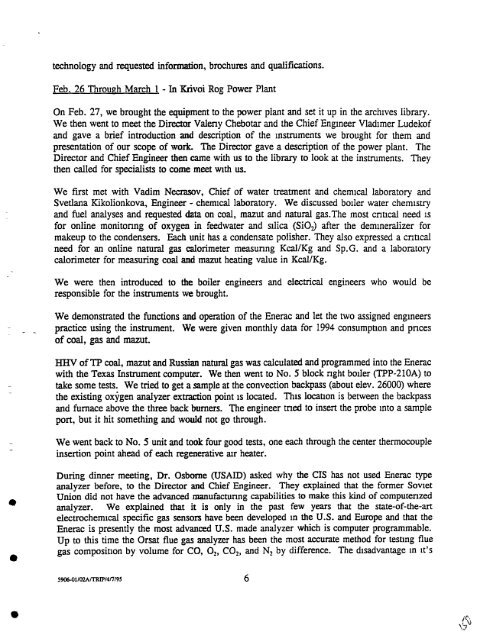4"12-Z 1 - part - usaid
4"12-Z 1 - part - usaid
4"12-Z 1 - part - usaid
Create successful ePaper yourself
Turn your PDF publications into a flip-book with our unique Google optimized e-Paper software.
•<br />
•<br />
•<br />
technology and requested information, brochures and qualifications.<br />
Feb. 26 Through March 1 - In Krivoi Rog Power Plant<br />
On Feb. 27, we brought the equipment to the power plant and set it up in the archIves library.<br />
We then went to meet the Director Valeny Chebotar and the Chief Engineer Vladlmer Ludekof<br />
and gave a brief introduction and description of the Instruments we brought for them and<br />
presentation of our scope of work. The Director gave a description of the power plant. The<br />
Director and Chief Engineer then came with us to the library to look at the instruments. They<br />
then called for specialists to come meet WIth us.<br />
We first met with Vadim Necrasov, Chief of water treatment and chemIcal laboratory and<br />
Svetlana Kikolionkova, Engineer - chemIcal laboratory. We discussed bOller water chemIStry<br />
and fuel analyses and requested data on coal, mazut and natural gas.The most cnttcal need IS<br />
for online monitonng of oxygen in feedwater and SIlica (Si0:J after the demIneralizer for<br />
makeup to the condensers. Each unit has a condensate polisher. They also expressed a cnttcal<br />
need for an online natural gas calorimeter measunng Kca1/Kg and Sp.G. and a laboratory<br />
calorimeter for measuring coal and mazut heating value in Kcal/Kg.<br />
We were then introduced to the boiler engineers and electrical engineers who would be<br />
responsible for the instruments we brought.<br />
We demonstrated the functions and operation of the Enerac and let the two assigned engineers<br />
practice using the instrument. We were given monthly data for 1994 consumptIOn and pnces<br />
of coal, gas and mazut.<br />
HHV ofTP coal, mazut and Russian natural gas was calculated and programmed into the Enerac<br />
with the Texas Instrument computer. We then went to No.5 block nght boiler (TPP-21OA) to<br />
take some tests. We tried to get a sample at the convection backpass (about elev. 26000) where<br />
the existing oxygen analyzer extr3Ction point IS located. This locatton is between the backpass<br />
and furnace above the three back burners. The engineer tned to insert the probe lOto a sample<br />
port, but it hit something and would not go through.<br />
We went back to No.5 unit and took four good tests, one each through the center thermocouple<br />
insertion point ahead of each regenerative air heater.<br />
During dinner meeting, Dr. Osborne (USAID) asked why the CIS has not used Enerac type<br />
analyzer before, to the Director and Chief Engineer. They explained that the former SOVIet<br />
Union did not have the advanced manufactunng capabilities to make this kind of computenzed<br />
analyzer. We explained that it is only in the past few years that the state-of-the-art<br />
electrochemIcal specific gas sensors have been developed In the U.S. and Europe and that the<br />
Enerac is presently the most advanced U.S. made analyzer which is computer programmable.<br />
Up to this time the Orsat flue gas analyzer has been the most accurate method for testmg flue<br />
gas composition by volume for CO, O 2 , CO 2 , and N 2 by difference. The dIsadvantage In It's<br />
S906-01I02A1TR1P/4n195 6

















